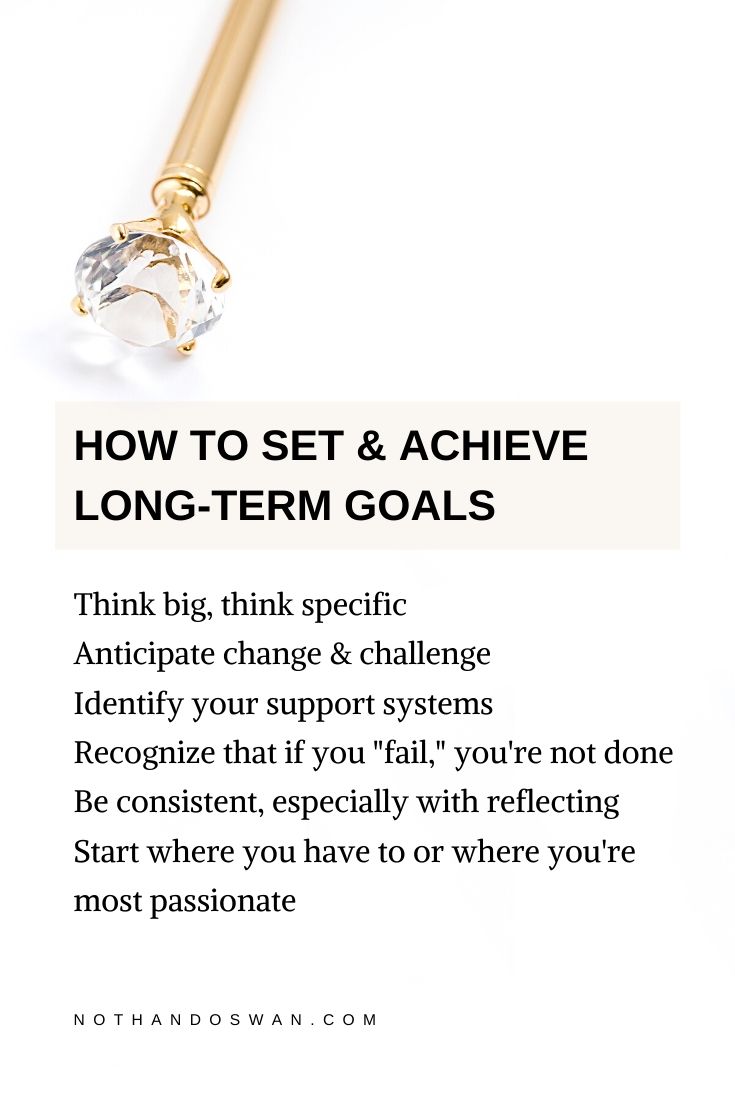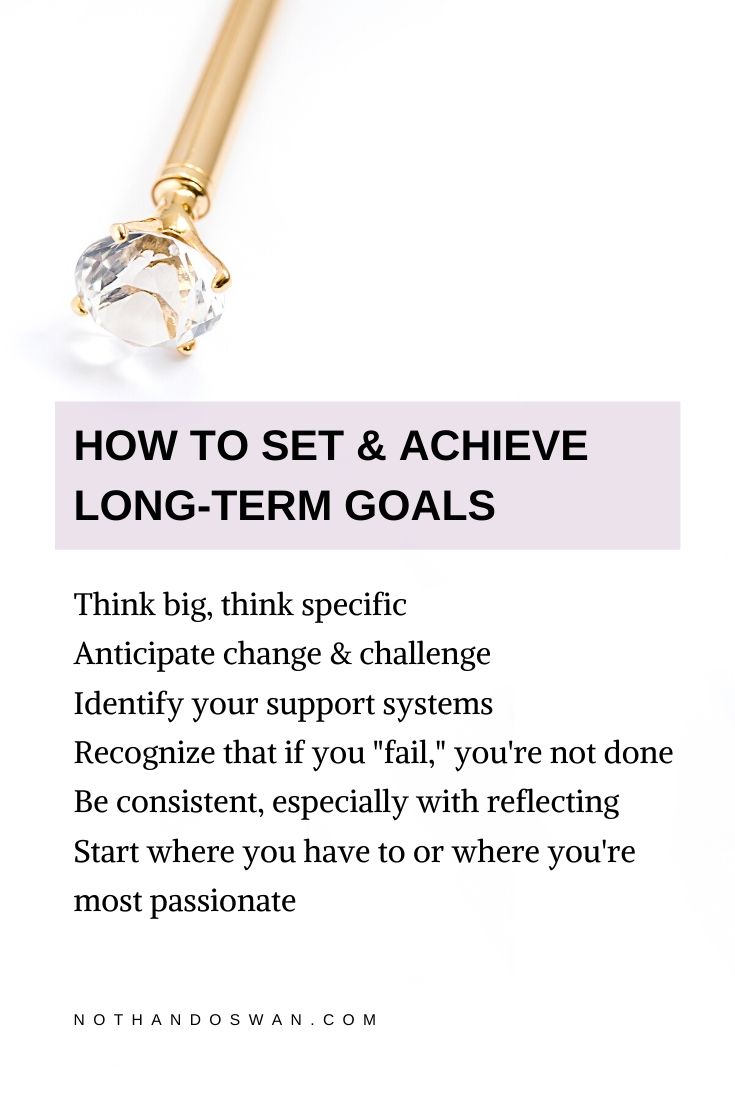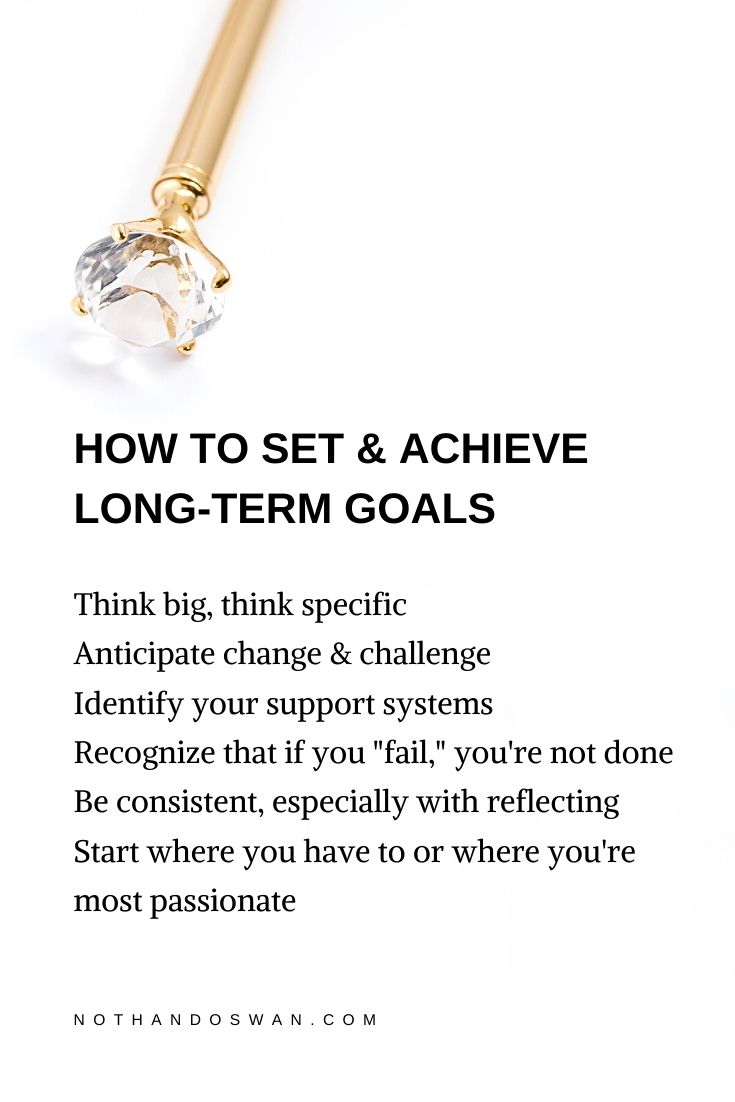
Going back to school was so hard. I have no idea how my younger self did all these projects and studied for all these tests! And since I already have the best full-time job in the world, it’s going to take me a long time to get my master’s in public health.
But obviously, multi-passionate women get things done by having clear, long-term goals. In this post, I’m going to walk you through five steps to set and achieve these goals, plus some extra bonuses at the end.
Also, make sure to grab the free Focus Planner that goes with this post so that you can stay focused on only the goals that matter to you.
Long-term goal setting STEP ONE: think big, think specific
Anytime you hear about setting goals, the SMART goal acronym pops up, and so I’m not going to spend a lot of time breaking that down. What I do want to mention is how you can pair it with the 5-4-3-2-1 method to move into action.
The SMART goal acronym reminds us that when we’re setting goals, they need to be:
- Specific
- Measurable
- Achievable
- Relevant, and
- Time-bound
When it comes to multi-passionate women, the most important letter in this acronym is the R: are the goals you’re setting relevant to you and your interests? What are you most passionate about, and do your goals reflect this?
Now think big here. When we’re setting long-term goals, we’ve got, well, time. And because you have time, don’t limit yourself. Dream as big as you can.
Then, go ahead and use the 5-4-3-2-1 method to map out exactly what achieving this goal is going to entail. Essentially, with the big picture in mind, you’ll reverse engineer a roadmap to get you there. What will things look like in 5 years? What actions can you take in the next 4 months, 3 weeks, 2 days, and in the next 1 hour to get you there?
Remember, in this step, we’re thinking long-term and we’re visualizing the best possible scenario. So think big, but also be specific and concrete.
Long-term goal setting STEP TWO: Anticipate the 2 Cs
Change and challenge.
Starting this master’s program has been all about these 2 C’s. To be honest, I wasn’t quite sure I’d get into the program because my application was made at literally the last possible moment. I had to be flexible in pursuing my graduate training. I constantly changed my plans.
First, there were so many different ways that I thought I might get it. Initially, I thought I’d do a combined family medicine and public health residency program. So I explored my options but changed my mind about getting my master’s that way. Then, I thought I’d take a year off to do my master’s in the States because I’d been exposed to some amazing programs there. But in the end, I decided to do my master’s part-time, not full-time, and at home, not abroad.
That covers the first C (change).

On top of that, though, I’ve had challenges. I remember one of my very first assignments was to write a briefing note on a specific health topic. Did I know what a briefing note was at that time? Not at all. Did I know that it would take me over ten hours to write it? I wish I did!
Instead, I struggled to submit that assignment after a half-day clinic, and I’ll just tell you now: I did horribly. And not a perfectionist’s “horribly,” but actually horribly.
But the thing is, when we’re setting long-term goals, we have to anticipate a certain amount of difficulty and deviation from our original plans.
Establishing the goal and then setting up a game plan in step one is so key, but it’s even more important to be able to adjust your goals. How you thought you were going to get there may or may not actually be the case. And your path to success will include some failure.
Long-term goal setting STEP THREE: Identify your support
Along the lines of failure, make sure you know who you can call on when things get tough.
Let’s just be real. I have done nothing impressive on my own. Every single accomplishment that I have made has been done with someone special by my side or working through me. By the way, those people have the funniest stories about me, but this is my blog, not theirs, so we’re going to save those.
Most times when we’re working towards something important, it’s time-consuming. Factor in that multi-passionate women are often working towards more than one thing, and things get really busy.
With this in mind, it’s so important to build community both within and outside of your passions. I have colleagues who are interested in public health, and then I have friends who are just interested in me. They are both amazing groups of people.

So whether it be within formal mentorship relationships or in informal come-to-my-place-and-let’s-have-tea relationships, you’re going to need help when you’re exhausted or doubting yourself or thinking of abandoning what you set out to do.
Just as you’re working towards your goals, make sure you’re also nurturing those relationships.
Long-term goal setting STEP FOUR: Recognize that if you “fail,” you’re not done
Last bit on this idea of failure: I hope it happens to you. I really hope that as you’re working towards your long-term goals, you encounter some form of “failure.”
Make that several failures. Several opportunities to stop, pause, and reflect. Several hiccups that make your song of success a bit more staccato. These are all opportunities to get clearer on your vision, your measurables, and what’s actually making a difference. How can you improve on your plan from step one?
Are you doing the work?

Now, let me be clear: I also want you to succeed. But I want you to fail first, or at least make minor tweaks. I want you to truly root into your purpose, determination, and support systems.
It’s not that I want you to make poor choices or to lose it all. I don’t want you to backtrack or burn bridges, and I definitely hope you pass your exams the first time around. I just hope you have the opportunity to learn and grow along the way as well.
If you’re not where you want to be, then the trip’s not over. Someone has used the emergency alert system on the train and response personnel are on the way. The train is delayed, but you’re on the right track, and you’ll be provided with more information once it becomes available.
Oh, city transit. Let’s move on from the analogies, Nothando.
Long-term goal setting STEP FIVE: Be consistent, especially in reflecting
I know I saved the most cliche step for last, but it’s important. We all know that the key to achieving any long-term goal is to stay at it. Similarly, the key to doing well in a course is not to cram at the last minute but to do the work from the jump (it’s a hard truth).
So in this last step, I want you to commit to your long-term goals (no duh).
But remember that they’re LONG-term. So many of us get frustrated or are hard on ourselves about not seeing huge gains, all the while forgetting that these things take time. When I first started my master’s program, I was fixated on how it was going to take forever, completely discounting the fact that I also work.
The other thing that happens with time is that things can get muddy. That resolution that you had at the beginning of the year might not be so clear once the holiday season rolls around. So, as you’re making those small, consistent steps, just make sure you’re on the right runway, striking the right poses.
So where do you start?
Listen, girl. I get this question, and I’m so glad you asked because when you’re multi-passionate, you can be working on so many different projects. The answer to where to start, in a nutshell, is where you have to or where you’re most excited to.
If you’re in a space where you need to work towards one of your goals before you can start on the other, then make that a priority. Focus your energy on the one thing. (Again, don’t forget to download your Focus Planner to help you get clear on what you can make space for and what you’ll have to put on hold.)
For me, I decided to finish my family medicine residency before starting my master’s in public health. Of course, I had my graduate program in mind, but at that point in my life, residency was my first priority.
If, however, you’re in a stable position thanks to all the work you’ve done in the past, then start with whatever goal you’re most excited about. Get it!
You deserve to make time and space for whatever fills you up. Feel free to work on one thing or many things, as long as you can work through the previous steps in this post for each of your long-term goals.
Summary
So many times, as multi-passionate career women, we’re told to focus on just one thing. To be the best and to stay focused. But the thing is, a fulfilling life is filled with all of our passions. So, it’s important to set long-term goals that reflect each one of them.
In this post, we talked about thinking big and being specific. We also talked about how to turn these dreams into reality, while leaving room for ebbs and flows.
And perhaps most importantly, we mentioned the role of supports and “failure” in all of this.
Remember, you’re either going to start where you have to (keeping your other goals in mind) or where you’re most excited to.
If you’re ready to take this concept further and apply it to your unique situation, let’s set up a consult call. In 60 minutes, we’ll mastermind your current goals, the steps to achieve them, and whether one-on-one coaching is the next best investment for you and your goals.

